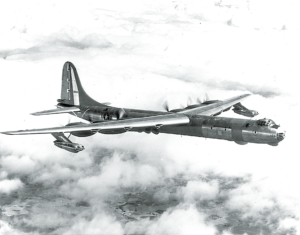The discovery of a bomb casing in a lake in northern Minnesota’s Big Bog—technically named the Red Lake Peatlands—led Doug Easthouse, DNR park manager of the Big Bog State Recreation Area and two other state parks, to research how a bomb got into the bog. What he uncovered was almost 20 years of military history when the Big Bog was used as a bombing and artillery range.
Easthouse first heard about the bomb in August 2010 from two researchers who had been studying the ecosystem of bogs since the 1970s. They found the bomb casing in the bog’s two-acre Hillman Lake, while looking for a meteorite they thought had created the lake.
Sometimes called Minnesota’s last true wilderness, Big Bog, which covers about 500 square miles and is the largest in the lower 48 states, was formed over the past 5,000 years. It is located north of Red Lake in the northern unit of the two-unit Big Bog State Recreation Area. A mile-long (1.6 km) boardwalk with benches and interpretive signs allows visitors to explore the “islands” of stunted spruce within the sprawling bog, which contains open wetlands and unique plants.

In his article “Bombing the Big Bog” in the Minnesota Conservation Volunteer (Jan.-Feb. 2016), Easthouse wrote, “…during World War II and the beginning of the Cold War, the roar of low-flying military planes dive-bombing targets rocked this place. So did the rapid fire of .50-caliber machine guns, the bark of howitzers, and the shock of huge explosions in the night sky.”
It was during World War II that the U.S. Army established a bombing and anti-aircraft range in the Red Lake Peatland. From 1947 to 1952, pilots flew over this bog, bombing targets all day and into the night with miniature AN MK-23 practice bombs, 100-pound water-filled bombs and .50 sub-caliber aircraft rockets.
When the war ended and Cold War began between the West and the Soviet Union, there were fears the U.S. would be attacked by the Russians. Duluth was named the 11th most strategic air target in the U.S., and their National Guard units became anti-aircraft artillery units. Huge convoys of trucks moved troops and howitzers to northern Minnesota to train at the bog during the summer months, from 1948 to 1953.
Easthouse wrote in his article, “During weeklong encampments, brave pilots in B-26 bombers flew over the bog, towing targets for guard units to fire at. F-51 Mustang fighters stationed in Minneapolis would rip through the sky to catch B-26s and pepper the targets they towed. Radio-controlled, 8-foot-long unmanned planes darted across the bog as men on the ground tried to shoot them down.”
From 1949 to 1951, a co-operative bombing project called Operation Woosh between the Naval Reserve and the Minnesota Department of Conservation, helped create a habitat for moose by dropping live bombs to create wallowing holes for some 5,000 moose to find protection from biting insects. In a Letter to the Editor in Popular Mechanics 1951, Bill Greer, Lt. Commander, USNR, NAS Minneapolis, wrote about how the project used “heavy weapons of war” to blast holes in the “floating cover of the Red Lake bog area, thus forming new wallows…Twenty-five one-ton bombs and an equal number of 1,000-pounders blasted 50 craters in the bog.”

The bog also played a role in Operation Deep Freeze, a project from 1951 to 1955 set up by U.S. Air Force and Sandia National Laboratories. Northern Minnesota was chosen to test fuses for nuclear bombs in cold conditions that were similar to Soviet Union winters. In 1951, B-36 Peacemakers and B-47 Stratojet bombers flew from bases in New Mexico and South Dakota, carrying the giant Mark IV bomb without is nuclear core. Mark IV weighed nearly 11,000 pounds, was 60 inches in diameter, 128 inches in length, and would be set to detonate about 3,000 feet above a lighted target on Upper Red Lake. It was similar to the atomic bomb dropped in Nagasaki, Japan.
In 1953, an Australian newspaper reported in an article from Canada, “Atom Bomb Tests in Minnesota” that the civil defense director of International Falls had said in a ‘secret’ joint meeting with Canadians that B-36 Peacemaker bombers in early 1953 had dropped three separate atomic bombs with the nuclear material removed and detonated them 4,000 feet above Upper Red Lake. The report was denied by the AEC.
In his article, “Red Lake Peatland Atomic Fuse Test,” Jesse Olson wrote, “The fuse tested over Upper Red Lake belonged to the implosion-type bomb. This meant that even without the nuclear material, the bomb contained thousands of pounds of conventional explosives.”
The atomic bombs were fitted with parachutes so they would slowly fall toward the ground, giving planes time to get away from the area. The altitude fuses being tested would detonate the bomb when they reached the proper height above the ground.
Sometime in the 1960s, all military activity ceased and the bog began to heal. Floating mats of sphagnum now cover most of the moose wallows. In 1975, the National Park Service designated the Upper Red Lake Peatland as a National Natural Landmark under the Historic Sites Act.

